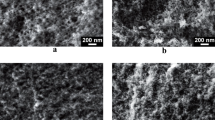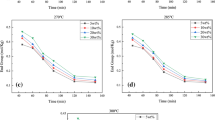Abstract
The kinetics of resorcinol–formaldehyde polycondensation was investigated by DSC. The resorcinol–formaldehyde polycondensation mixtures were prepared using different catalyst (Na2CO3) concentrations (molar ratio of resorcinol/catalyst R/C = 25 and 50) and mass contents of reactants (w = 20 and 40%). The studied polycondensation mixtures were heated from 10 to 100 °C at five different heating rates (0.5–2.5 °C min−1). The two obtained DSC peaks correspond with two reaction steps (formation of hydroxymethyl derivatives of resorcinol and polycondensation reaction itself). The overall reaction heat evolved during both steps corresponds to 97–104 kJ mol−1 for all mixtures. Based on the kinetic analysis, the first reaction step is best fitted by the second-order kinetic model and its rate is controlled by chemical reaction. The second reaction step can be described by R3 mechanism and is probably limited by diffusion in more viscous solution. Found kinetics equation allows to predict the composition of reaction mixture during the polycondensation at least at micro-scale. The obtained results can be useful for prediction of reaction course which can control the porosity of resorcinol–formaldehyde gels.




Similar content being viewed by others
References
Wen J, Wilkes GL. Organic/inorganic hybrid network materials by the sol-gel approach. Chem Mater. 1996;8:1667–81.
Pekala RW, Alviso CT, Kong FM, Hulsey SS. Aerogels derived from multifunctional organic monomers. J Non-Cryst Solids. 1992;145:90–8.
Frackowiak E, Béguin F. Carbon materials for the electrochemical storage of energy in capacitors. Carbon. 2001;39:937–50.
Lazzari M, Soavi F, Mastragostino M. High voltage, asymmetric EDLCs based on xerogel carbon and hydrophobic IL electrolytes. J Power Sour. 2008;178:490–6.
Lewicki JP, Fox CA, Worsley MA. On the synthesis and structure of resorcinol-formaldehyde polymeric networks: precursors to 3D-carbon macroassemblies. Polymer. 2015;69:45–51.
Hall PJ, Mirzaeian M, Fletcher SI, Sillars FB, Rennie AJR, Shitta-Bey GO, et al. Energy storage in electrochemical capacitors: designing functional materials to improve performance. Energy Environ Sci. 2010;3:1238–51.
Kabbour H, Baumann TF, Satcher Joe H, Saulnier A, Ahn CC. Toward new candidates for hydrogen storage: high-surface-area carbon aerogels. Chem Mater. 2006;18:6085–7.
Tonanon N, Wareenin Y, Siyasukh A, Tanthapanichakoon W, Nishihara H, Mukai SR, et al. Preparation of resorcinol formaldehyde (RF) carbon gels: Use of ultrasonic irradiation followed by microwave drying. J Non-Cryst Solids. 2006;352:5683–6.
Taylor SJ, Haw MD, Sefcik J, Fletcher AJ. Gelation mechanism of resorcinol-formaldehyde gels investigated by Dynamic light scattering. Langmuir. 2014;30:10231–40.
El Khatat AM, Al-Muhtaseb SA. Advances in tailoring resorcinol-formaldehyde organic and carbon gels. Adv Mater. 2011;23:2887–903.
Pekala RW, Kong FM. A synthetic route to organic aerogels-mechanism, structure, and properties. J Phys Colloq. 1989;50:C4-33–40.
Al-Muhtaseb SA, Ritter JA. Preparation and properties of resorcinol-formaldehyde organic and carbon gels. Adv Mater. 2003;15:101–14.
Pekala RW, Alviso CT, Lu X, Gross J, Fricke J. New organic aerogels based upon a phenolic-furfural reaction. J Non-Cryst Solids. 1995;188:34–40.
Pekala RW, Farmer JC, Alviso CT, Tran TD, Mayer ST, Miller JM, et al. Carbon aerogels for electrochemical applications. J Non-Cryst Solids. 1998;225:74–80.
Shen J, Li J, Chen Q, Luo T, Yu W, Qian Y. Synthesis of multi-shell carbon microspheres. Carbon. 2006;44:190–3.
Wang J, Glora M, Petricevic R, Saliger R, Proebstle H, Fricke J. Carbon cloth reinforced carbon aerogel films derived from resorcinol formaldehyde. J Porous Mater. 2001;8:159–65.
Brandt R, Petricevic R, Pröbstle H, Fricke J. Acetic acid catalyzed carbon aerogels. J Porous Mater. 2003;10:171–8.
Coteţ LC, Danciu V, Coşoveanu V, Popescu IC, Anna R, Molins E. Synthesis of meso-and macroporous carbon aerogels. Rev Roum Chim. 2007;52:1077–81.
Oyedoh E, Albadarin A, Walker GM, Mirzaeian M, Ahmad M. Preparation of controlled porosity resorcinol formaldehyde xerogels for adsorption applications. Chem Eng Trans. 2013;32:1651–6.
Feng J, Feng J, Zhang C. Shrinkage and pore structure in preparation of carbon aerogels. J Sol-Gel Sci Technol. 2011;59:371–80.
Werstler DD. Quantitative 13C n.m.r. characterization of aqueous formaldehyde resins: 2. Resorcinol-formaldehyde resins. Polymer. 1986;27:757–64.
Šebenik A, Osredkar U, Vizovišek I. Study of the reaction between resorcinol and formaldehyde. Polymer. 1981;22:804–6.
Raff RAV, Silverman BH. Kinetics of the uncatalyzed reactions between resorcinol and formaldehyde. Ind Eng Chem. 1951;43:1423–7.
Gaca KZ, Parkinson JA, Sefcik J. Kinetics of early stages of resorcinol-formaldehyde polymerization investigated by solution-phase nuclear magnetic resonance spectroscopy. Polymer. 2017;110:62–73.
Christiansen AW. Resorcinol–formaldehyde reactions in dilute solution observed by carbon-13 NMR spectroscopy. J Appl Polym Sci. 2000;75:1760–8.
Moudrakovski IL, Ratcliffe CI, Ripmeester JA, Wang L-Q, Exarhos GJ, Baumann TF, et al. Nuclear magnetic resonance studies of resorcinol-formaldehyde aerogels. J Phys Chem B. 2005;109:11215–22.
Menczel JD, Prime RB, editors. Thermal analysis of polymers: fundamentals and applications. Hoboken: John Wiley; 2009.
Vyazovkin S, Sbirrazzuoli N. Isoconversional kinetic analysis of thermally stimulated processes in polymers. Macromol Rapid Commun. 2006;27:1515–32.
Vyazovkin S, Burnham AK, Criado JM, Pérez-Maqueda LA, Popescu C, Sbirrazzuoli N. ICTAC kinetics Committee recommendations for performing kinetic computations on thermal analysis data. Thermochim Acta. 2011;520:1–19.
Wiener M, Reichenauer G, Scherb T, Fricke J. Accelerating the synthesis of carbon aerogel precursors. J Non-Cryst Solids. 2004;350:126–30.
Starink MJ. The determination of activation energy from linear heating rate experiments: a comparison of the accuracy of isoconversion methods. Thermochim Acta. 2003;404:163–76.
Saeed RM, Schlegel JP, Castano C, Sawafta R. Uncertainty of thermal characterization of phase change material by differential scanning calorimetry analysis. Int J Eng Res. 2016;5:9.
Job N, Pirard R, Marien J, Pirard J-P. Porous carbon xerogels with texture tailored by pH control during sol–gel process. Carbon. 2004;42:619–28.
Tonge LY, Hodgkin J, Blicblau AS, Collins PJ. Effects of initial phenol-formaldehyde (PF) reaction products on the curing properties of PF resin. J Therm Anal Calorim. 2001;100:10.
Vyazovkin S. Isoconversional kinetics of thermally stimulated processes. Cham: Springer; 2015. https://doi.org/10.1007/978-3-319-14175-6.
Knop A, Scheib W. Chemistry and application of phenolic resins. Berlin: Springer; 1979. www.springer.com/cn/book/9783540090519.
Acknowledgements
This work was financially supported by the Ministry of Education, Youth and Sports of the Czech Republic in the “National Feasibility Program I,” Project LO1208 “TEWEP” and by EU structural funding Operational Programme Research and Development for Innovation, Project No. CZ.1.05/2.1.00/19.0388.
Author information
Authors and Affiliations
Corresponding author
Rights and permissions
About this article
Cite this article
Kinnertová, E., Slovák, V. Kinetics of resorcinol–formaldehyde polycondensation by DSC. J Therm Anal Calorim 134, 1215–1222 (2018). https://doi.org/10.1007/s10973-018-7532-0
Received:
Accepted:
Published:
Issue Date:
DOI: https://doi.org/10.1007/s10973-018-7532-0




